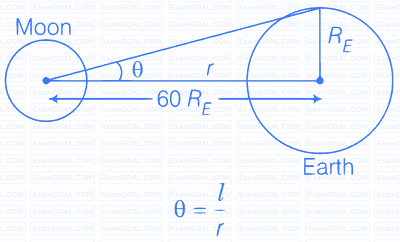Why length, mass and time are chosen as base quantities in mechanics?
Length, mass and time are chosen as base quantities in mechanics because:
(i) Length, mass and time cannot be derived from one another, that is these quantities are independent.
(ii) All other quantities in mechanics can be expressed in terms of length, mass and time.
(a) The earth-moon distance is about 60 earth radius. What will be the diameter of the earth (approximately in degrees) as seen from the moon?
(b) Moon is seen to be of (1/2)° diameter from the earth. What must be the relative size compared to the earth?
(c) From parallax measurement, the sun is found to be at a distance of about 400 times the earth-moon distance. Estimate the ratio of sun-earth diameters.
(a) $\text { Angle subtended at distance } r \text { due to an arc of length } l \text { is }$

Given,
$$ \begin{aligned} l & =R_E ; r=60 R_E \\\\ \theta & =\frac{R_E}{60 R_E}=\frac{1}{60} \mathrm{rad}=\frac{1}{60} \times \frac{180}{\pi} \text { degree } \\\\ & =\frac{3}{\pi} \approx 1^{\circ} \end{aligned} $$
Hence, angle subtended by diameter of the earth $=2 \theta=2^{\circ}$.
(b) Given that moon is seen as $\left(\frac{1}{2}\right)^{\circ}$ diameter and earth is seen as $2^{\circ}$ diameter.
Hence, $$ \frac{\text { Diameter of earth }}{\text { Diameter of moon }}=\frac{(2 / \pi) \mathrm{rad}}{\left(\frac{1}{2 \pi}\right) \mathrm{rad}}=4 $$
(c) From parallax measurement given that sun is at a distance of about 400 times the earth-moon distance, hence, $\frac{r_{\text {sun }}}{r_{\text {moon }}}=400$
(Suppose, here $r$ stands for distance and $D$ for diameter) sun and moon both appear to be of the same angular diameter as seen from the earth.
$\therefore \frac{D_{\text {sun }}}{r_{\text {sun }}}=\frac{D_{\text {moon }}}{r_{\text {moon }}}$
$\therefore \frac{D_{\text {sun }}}{D_{\text {moon }}}=400$
But $\frac{D_{\text {earth }}}{D_{\text {moon }}}=4$
$\therefore \frac{D_{\text {sun }}}{D_{\text {earth }}}=100$
Which of the following time measuring devices is most precise?
A wall clock
A stop watch
A digital watch
An atomic clock
A wall clock can measure time correctly upto one second. A stop watch can measure time correctly upto a fraction of a second. A digital watch can measure time upto a fraction of second. An atomic clock can measure time most precisely as its precision is 1s in 1013 s.
The distance of a galaxy is of the order of 1025 m. Calculate the order of magnitude of time taken by light to reach us from the galaxy.
Given, distance of the galaxy = 1025 m
Speed of light = 3 × 108 m/s
Hence, time taken by light to reach us from galaxy is,
$t = \frac{\text{Distance}}{\text{Speed}} = \frac{10^{25}}{3 \times 10^8} \approx \frac{1}{3} \times 10^{17} = \frac{10}{3} \times 10^{16} = 3.33 \times 10^{16}$ s
The vernier scale of a travelling microscope has 50 divisions which coincide with 49 main scale divisions. If each main scale division is 0.5 mm, calculate the minimum inaccuracy in the measurement of distance.
Note:
Inaccuracy will be measured by the difference of 1MSD and 1VSD, where MSD = main scale division and VSD = vernier scale division.
By question, it is given that:
$50VSD = 49MSD $
$1MSD = \frac{50}{49} VSD $
$1VSD = \frac{49}{50} MSD $
Minimum inaccuracy = $1MSD - 1VSD $
$= 1MSD - \frac{49}{50}MSD $
$= \frac{1}{50} MSD $
Given, $1MSD = 0.5 $ mm
Hence, minimum inaccuracy = $\frac{1}{50} \times 0.5 $ mm $= \frac{1}{100} $ mm = 0.01 mm